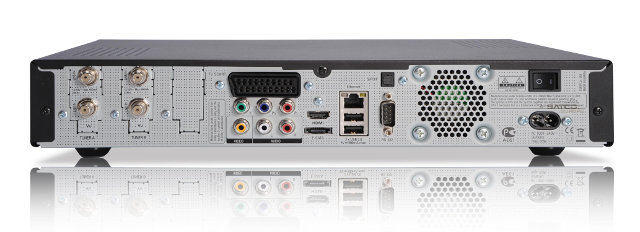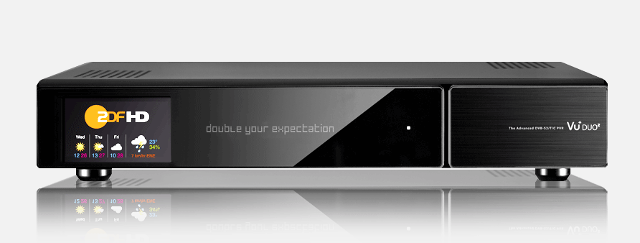Vu+ Duo2, Solo2 and Solo SE are high-end Linux based DVB receivers powered by Broadcom processors made by Ceru, and with a relatively active community of users and developers. All three models have recently received support for XBMC in their “Black Hole” firmware. Solo SE is the most recent model having been released in 2014, against Duo2 and Solo2 that have been selling since 2012 according to Wikipedia. Since I’ve never heard about these, I’ll check out Duo2, as it comes with the most features out of the three.
- SoC – Broadcom BCM7424 dual core MIPS processor @ 1.3 GHz with VideoCore IV GPU
- System Memory – 2GB RAM
- Storage – 1 GB NAND flash + SATA III interface for 2.5″ and 3.5″ HDD (internal) + eSATA +
- Video Output – HDMI, SCART, Composite, and Component (YPbPr)
- Audio Output – HDMI, stereo audio, and optical S/PDIF
- Tuners – 2x S2/C/T2 (Up to 4 tuners supported)
- Front Panel Displays – 3.2″ TFT LCD (262,000 color / 16-bit) + VFD display
- Connectivity – Gigabit Ethernet, 802.11 b/g/n Wi-Fi up to 300 Mbps
- USB – 3x USB 2.0 ports
- Misc – IR receiver, 2x Smart card slots, RS232 port,
- Power – 12V/1.5A
The box also supports 3DTV, PiP, on-the-fly video transcoding for mobile devices, up to 16 channels recording via four tuners, and is compliant with HbbTV providing access to TV guides, catch-up services, web video, VOD, or portable services. The Linux distributions used in Vu+ products is based on Enigma2, and it also supports OpenPLI, an open source software for set-top boxes based on Enigma2.

Vu+ Duo2 sells for 349 Euros on Satshop.TV or 399.99 GBP on Amazon UK. The other two Vu+ set-top boxes supporting XBMC/Kodi cost a bit less, as Vu+ Solo2 goes for 299 Euros, and the new Vu+ Solo SE (Second Edition) for 220 Euros. More details can be found on VuPlus website.
Thanks to Harley for the tip.

Jean-Luc started CNX Software in 2010 as a part-time endeavor, before quitting his job as a software engineering manager, and starting to write daily news, and reviews full time later in 2011.
Support CNX Software! Donate via cryptocurrencies, become a Patron on Patreon, or purchase goods on Amazon or Aliexpress






I stay informed of all the project MIPS and in recent weeks, OpenATV shares their GIT repository : https://github.com/oe-alliance/oe-alliance-core/tree/2.3/meta-brands/meta-vuplus/recipes-xbmc
At first glance, it uses no player “VPU”, just FFMPEG.
I tested the “Mut@nt 2400”, the video quality is horrible, and not even compatible 1080p.
issue this device is MIPS and they dont support real XBMC, they just made skin and plugin which looks as XBMC. Price is 500 eur, no 4k, low RAM and NAND Flash. Because it is MIPS many xbmc plugins are not working.
Serious?!?!?! my Wetek Play does all same natively and cost 100 euro!
I had a VU+ Solo and i’m tryng to sell it, it’s really like old century equipment… Nice but not useful…
Baaaaaah 400 EUR to spend cmon for that money I can buy x86 Intel NUC and attach whatever I want there. Also this device cant do any hardware audio and video decoding like CSylvain mentioned already.
Once I had MIPS based dreambox and I will never invest any penny for MIPS, as 10 years ago it was ok but now when need power to play different bitrate files gstreamer on mips cant do anything.
VU+ is known GPL violator and company which copied Enigma 2 from Dream Multimedia… typical Asia aproach.
This is not the same as that. This is a full source port of XBMC, not just an emulation clone on XBMC skin and look.
You are wrong on all accounts here. Unlike that other project this really is a full souce port of the real XBMC for MIPS, and not just a skin lookalike as that other project.
Reason why not all the plugins yet work as they should in this new port for Vu+ has nothing to do with them not being able to run on MIPS but rather the fact that this is unstable Beta releases. XBMC uses a Python engine for plugins and that is cross-platform so can run fine on MIPS once the project goes forward.
Know that this is an real commercial port project called XBMC4STB by Marusys Co., Ltd. which is the parent company to Ceru Company Ltd. who makes Vu+, and that Marusus are also the parent company of PrismCube which is another commercial XBMC based set-top box however it uses ARM hardware, but it was them to started the XBMC4STB port project.
From wikipedia:
http://en.wikipedia.org/wiki/Vu%2B#XBMC4STB_project_by_Vu.2B
XBMC4STB project by Vu+
In September 2011 Vu+ Day in Amsterdam it was first publicly announced that the next-generation Vu+ DVB satellite receivers to be released publicly in the end of 2012 will be ARM-powered and use XBMC Media Center (now renamed to Kodi Entertainment System) software for its main GUI, a OpenEmbedded-based development-project that they call “XBMC4STB” (XBMC for Set-Top-Boxes), with beta releases of both the software and new hardware said to be made available to XBMC developers before they will be release to the public.[4]
It took however two more years before a native source port of XBMC was available to use on the newer Vu+ (VuPlus) based set-top box models which are SoloSe, Solo2, and Duo2, (and no XBMC will not be made available for older Vu+ set-top boxes due to hardware limitations with missing OpenGL graphics acceleration).[5]
PrismCube by Marusys
Another set-top box hardware also using this XBMC4STB software fork of XBMC/Kodi is PrismCube, which is also produced by Vu+’s parent company, Marusys. Unlike Vu+, PrismCube is an ARM-architecture based DVB-S2 Twin-Tuner high-definition DVR/PVR that is only running native XBMC as its main media center GUI interface on-top of Linux for embedded systems.[6][7] Released in October 2013, this first hardware model is marketed as “PrismCube Ruby” in Europe, North Africa, and Middle East, and it is also sold under different brand names such as “Kasys Prismcube Ruby”, “AB IPBox Prismcube Ruby”, and “Openbox Prismcube Ruby”.[8]
PrismCube Ruby firmware image is based on OpenEmbedded-Linux, and uses Marusys’s own PVR backend software that integrated itself into XBMC’s GUI, so currently the PVR front-end GUI functions and features on PrismCube are not part of native XBMC core code, though they use the same skin texture elements to achieve some what similar look and feel interface, a ported fork which Marusys calls “XBMC4STB” (XBMC for Set-Top-Boxes), which is the same name that Vu+ have given to their XBMC port too.[9][10][11] Third-party firmware images for PrismCube Ruby is also being developed by the Black Hole Team, a team of independent developers of long popular community driven firmware images for Vu+-based set top-boxes.[12][13]
Also, BlackHole are not the only independent group of developers that makes third-party firmware images for Vu+ with this XBMC port from Ceru.
http://forum.kodi.tv/showthread.php?tid=213084
VTI is another independent group of developers that makes third-party firmware images for Vu+ with this XBMC port from Ceru.
Harley, I understand You as probably you are commercial or marketing representative of that company. VU+ is known GPL violator, company who steal Enigma 2 and just make hardware. Only devices which was and still are genuine with Enigma 2 are Dreambox devices from DreamMultimedia.
Vu+ not only is GPL violator from Korea, but also ugly expensive device running on MIPS cpu. I see on forums people complain that only few addons working. They cant watch movies as no hardware decoding of video.
Nope, I’m not associated with Vu+ or its parent company or resellers, or any other hardware for that matter.
I’m only a huge fan of XBMC/Kodi and also an avid GPL/LGPL and open source supporter, and in fact many of the XBMC/Kodi related stories here on cnx-software.com comes in as tips from myself, no matter which hardware or platform. Most news stories about XBMC here ends with “Thanks Harley”.
I know that Ceru/Vu+ have violated the GPL in the past but we can always hope they gets better, and PrismCube is mostly open source, though not fully, and at least they have not violated the GPL yet.
You are actually kind of funny mentioning Dreambox and DreamMultimedia in the same sentence as supporting GPL as DreamMultimedia have since a year back gone closed source and stopped supporting the open source. For that there is no excuse either.
@Sobtech
No, it does not. These MIPS based DVB tuners are a different beast: They are actually DVB tuners with added STB functionality. Being DVB tuners in the first place means, that they can control complicated satellite setups (http://en.wikipedia.org/wiki/DiSEqC). Gather program information from many different sources, have the setups for many satellite and terrestrial bouquets and so much more. Oh, and some they can stream any of their tuners via Ethernet in your local network. So you can watch Live-TV on your tablet in the bed, or, via VPN, check the local news from abroad. While the Wetek seems nice, it can’t do these things, I assume. The Wetek is an STB with added DVB functionality. The other devices are high-end DVB-Receivers with added STB functionality.
The come with up to four independent DVB-tuners (mine has 2x DVB-S and 1xDVB-T/C and place for a fourth one), that all can be streamed/recorded and are highly comfortable for TV watching, all with big communites supporting them, writing plugins, etc.
@.jon
Hi Jon,
All this you said i did natively with my WETEK! have all plugins of KODI that are 100 more that the ones available for VU+.
Btw i owned a VU+ in past that lucky i could sell it, it’s no comparison….
VU+ = Enigma ( and forget rest)
WEtek = Android + Openelec + KODI + TVHeadend + VDR + (seems now some guys por enigma)…
There is no compression possible…
BTW watch tv at my tablet works fine i can use 6 streams simulateneos how many you cam make with VU+ 😀
Can I use a Wetek box to see cable tv ?
I´d like install an Oscam in this box. .
Sanford, check/ask on wetek forum: http://www.wetekforums.com/
Last time I heard that officially this is not supported. But unofficially works with external USB card reader.
Is this device a good option to cable TV ?